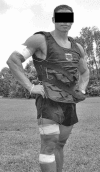Thermoregulatory influence of a cooling vest on hyperthermic athletes
- PMID: 18335014
- PMCID: PMC2231399
- DOI: 10.4085/1062-6050-43.1.55
Thermoregulatory influence of a cooling vest on hyperthermic athletes
Abstract
Context: Athletic trainers must have sound evidence for the best practices in treating and preventing heat-related emergencies and potentially catastrophic events.
Objective: To examine the effectiveness of a superficial cooling vest on core body temperature (T(c)) and skin temperature (T(sk)) in hypohydrated hyperthermic male participants.
Design: A randomized control design with 2 experimental groups.
Setting: Participants exercised by completing the heat-stress trial in a hot, humid environment (ambient temperature = 33.1 +/- 3.1 degrees C, relative humidity = 55.1 +/- 8.9%, wind speed = 2.1 +/- 1.1 km/hr) until a T(c) of 38.7 +/- 0.3 degrees C and a body mass loss of 3.27 +/- 0.1% were achieved.
Patients or other participants: Ten healthy males (age = 25.6 +/- 1.6 years, mass = 80.3 +/- 13.7 kg).
Intervention(s): Recovery in a thermoneutral environment wearing a cooling vest or without wearing a cooling vest until T(c) returned to baseline.
Main outcome measure(s): Rectal T(c), arm T(sk), time to return to baseline T(c), and cooling rate.
Results: During the heat-stress trial, T(c) significantly increased (3.6%) and, at 30 minutes of recovery, T(c) had decreased significantly (2.6%) for both groups. Although not significant, the time for return to baseline T(c) was 22.6% faster for the vest group (43.8 +/- 15.1 minutes) than for the no-vest group (56.6 +/- 18.0 minutes), and the cooling rate for the vest group (0.0298 +/- 0.0072 degrees C/min) was not significantly different from the cooling rate for the no-vest group (0.0280 +/- 0.0074 degrees C/min). The T(sk) during recovery was significantly higher (2.1%) in the vest group than in the no-vest group and was significantly lower (7.1%) at 30 minutes than at 0 minutes for both groups.
Conclusions: We do not recommend using the cooling vest to rapidly reduce elevated T(c). Ice-water immersion should remain the standard of care for rapidly cooling severely hyperthermic individuals.
Keywords: heatstroke; hyperthermia; hypohydration.
Figures
References
-
- Armstrong L.E. Performing in Extreme Environments. Champaign, IL: Human Kinetics; 2000. pp. 15–70.
-
- Clapp A.J, Bishop P.A, Muir I, Walker J.L. Rapid cooling techniques in joggers experiencing heat strain. J Sci Med Sport. 2001;4(2):160–167. - PubMed
-
- Cheuvront S.N, Kolka M.A, Cadarette B.S, Montain S.J, Sawka M.N. Efficacy of intermittent, regional microclimate cooling. J Appl Physiol. 2003;94(5):1841–1848. - PubMed
-
- Armstrong L.E, Crago A.E, Adams R, Roberts W.O, Maresh C.M. Whole-body cooling of hyperthermic runners: comparison of two field therapies. Am J Emerg Med. 1996;14(4):355–358. - PubMed
Publication types
MeSH terms
LinkOut - more resources
Full Text Sources
Medical




